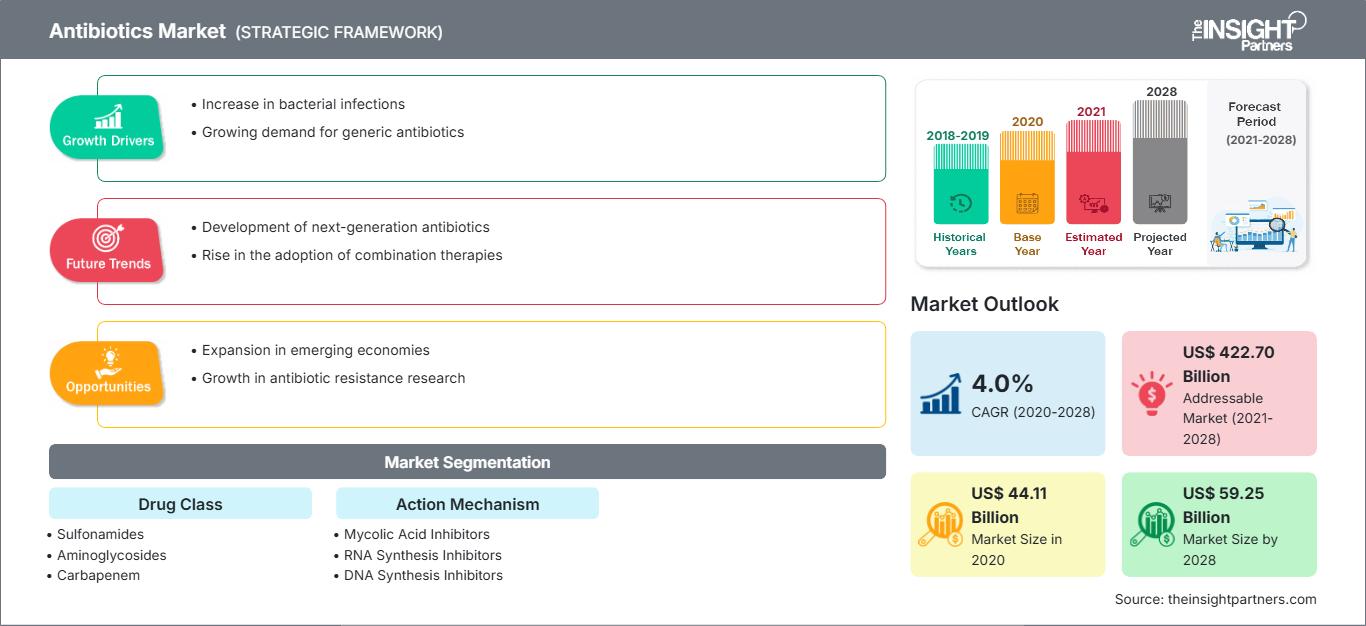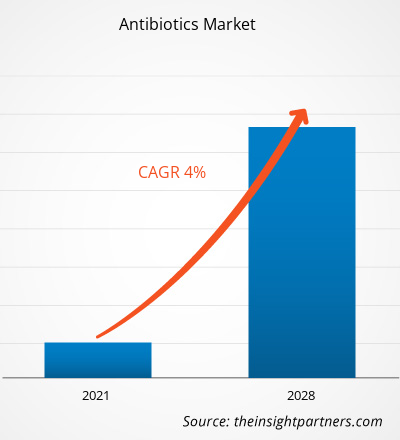El mercado de antibióticos se valoró en 44.111,31 millones de dólares estadounidenses en 2020 y se prevé que alcance los 59.253,24 millones de dólares estadounidenses en 2028; se espera que crezca a una tasa de crecimiento anual compuesta (TCAC) del 4,0% durante el período 2021-2028.
Los antibióticos son medicamentos potentes que se utilizan para combatir infecciones y enfermedades bacterianas. Se emplean específicamente para tratar infecciones causadas por bacterias como estafilococos, estreptococos o Escherichia coli. Los antibióticos eliminan las bacterias (bactericidas) o impiden su reproducción y crecimiento (bacteriostáticos). Los antibióticos no son efectivos contra las infecciones virales. Algunas de las infecciones comunes que se tratan con antibióticos son la conjuntivitis, las infecciones de piel o tejidos blandos, las infecciones de las vías respiratorias superiores, la bronquitis y la faringitis estreptocócica (faringitis estreptocócica), entre otras.
Perspectivas del mercado
Aumento del desarrollo de medicamentos genéricos
Un medicamento genérico es una copia de un fármaco de marca que ya no está protegido por patente. Las versiones genéricas se introducen en el mercado con el objetivo de ofrecer medicamentos a precios asequibles y ampliar su acceso a personas de diferentes estratos socioeconómicos. Su popularidad se debe a su disponibilidad y asequibilidad. Por ejemplo, según un estudio publicado por el NCBI en 2018, el precio promedio de una receta de medicamento de marca era casi cuatro veces mayor que el precio promedio de un genérico. Además, las empresas también se centran en el desarrollo de versiones genéricas con el fin de ofrecer antibióticos a precios mínimos. Por ejemplo, en junio de 2018, Lupin lanzó la solución para inhalación de tobramicina genérica en el mercado estadounidense. Asimismo, se prevé que el apoyo de las autoridades gubernamentales impulse la producción de antibióticos genéricos, lo que a su vez impulsará el crecimiento del mercado de antibióticos durante el período de pronóstico. Por ejemplo, en febrero de 2019, la Administración de Alimentos y Medicamentos de Estados Unidos (FDA) anunció la aprobación para la comercialización en Estados Unidos de medicamentos genéricos fabricados por empresas farmacéuticas indias.
Obtendrá personalización en cualquier informe, sin cargo, incluidas partes de este informe o análisis a nivel de país, paquete de datos de Excel, así como también grandes ofertas y descuentos para empresas emergentes y universidades.
Mercado de antibióticos: Perspectivas estratégicas

-
Obtenga las principales tendencias clave del mercado que se describen en este informe.Esta muestra GRATUITA incluirá análisis de datos, que abarcarán desde tendencias de mercado hasta estimaciones y pronósticos.
Información sobre el tipo de prueba
Según su clase farmacológica, el mercado de antibióticos se segmenta en sulfonamidas, aminoglucósidos, carbapenémicos, macrólidos, fluoroquinolonas, penicilinas, cefalosporinas y otros. El segmento de cefalosporinas representó la mayor cuota de mercado en 2020; mientras que se prevé que el segmento de fluoroquinolonas registre la mayor tasa de crecimiento anual compuesto (TCAC) durante el período de pronóstico.
Perspectivas sobre el mecanismo de acción
Según su mecanismo de acción, el mercado de antibióticos se ha segmentado en inhibidores del ácido micólico, inhibidores de la síntesis de ARN, inhibidores de la síntesis de ADN, inhibidores de la síntesis de proteínas e inhibidores de la síntesis de la pared celular. El segmento de inhibidores de la síntesis de la pared celular representó la mayor cuota de mercado en 2020, mientras que se estima que el segmento de inhibidores de la síntesis de ADN registrará la mayor tasa de crecimiento anual compuesto (TCAC) durante el período de pronóstico.
Las empresas suelen adoptar estrategias de lanzamiento y aprobación de productos para expandir su presencia y cartera de productos a nivel mundial y satisfacer la creciente demanda.
Las empresas que operan en el mercado de antibióticos adoptan la estrategia de expansión para ampliar su base de clientes en todo el mundo, lo que también les permite mantener su marca a nivel global. Por ejemplo, en julio de 2019, Pfizer lanzó un consorcio internacional de investigación para descubrir y desarrollar nuevos antibióticos contra la tuberculosis en colaboración con ocho socios biotecnológicos e instituciones académicas europeas.
Perspectivas regionales del mercado de antibióticos
Los analistas de The Insight Partners han explicado en detalle las tendencias regionales y los factores que influyen en el mercado de antibióticos durante el período de previsión. Esta sección también analiza los segmentos del mercado de antibióticos y su distribución geográfica en Norteamérica, Europa, Asia Pacífico, Oriente Medio y África, y Sudamérica y Centroamérica.
Alcance del informe de mercado de antibióticos
| Atributo del informe | Detalles |
|---|---|
| Tamaño del mercado en 2020 | 44.110 millones de dólares estadounidenses |
| Tamaño del mercado para 2028 | 59.250 millones de dólares estadounidenses |
| Tasa de crecimiento anual compuesto global (2020 - 2028) | 4,0% |
| Datos históricos | 2018-2019 |
| período de previsión | 2021-2028 |
| Segmentos cubiertos |
Por clase de fármaco
|
| Regiones y países cubiertos |
América del norte
|
| Líderes del mercado y perfiles de empresas clave |
|
Densidad de los actores del mercado de antibióticos: comprensión de su impacto en la dinámica empresarial
El mercado de antibióticos está creciendo rápidamente, impulsado por la creciente demanda de los usuarios finales debido a factores como la evolución de las preferencias de los consumidores, los avances tecnológicos y una mayor conciencia de los beneficios del producto. A medida que aumenta la demanda, las empresas amplían su oferta, innovan para satisfacer las necesidades de los consumidores y aprovechan las nuevas tendencias, lo que impulsa aún más el crecimiento del mercado.

- Obtenga una visión general de los principales actores del mercado de antibióticos.
Mercado mundial de antibióticos: por clase de fármaco
- Cefalosporina
- Penicilina
- Fluoroquinolonas
- Macrólidos
- Carbapenem
- Aminoglucósidos
- sulfonamidas
- Otros
Mercado mundial de antibióticos – Por mecanismo de acción
- Inhibidores de la síntesis de la pared celular
- Inhibidores de la síntesis de proteínas
- Inhibidores de la síntesis de ADN
- Inhibidores de la síntesis de ARN
- Inhibidores del ácido micólico
- Otros
Antibióticos a nivel mundial – Por geografía
-
América del norte
- A NOSOTROS
- Canadá
- México
-
Europa
- Francia
- Alemania
- Italia
- Reino Unido
- España
- El resto de Europa
-
Asia Pacífico (APAC)
- Porcelana
- India
- Corea del Sur
- Japón
- Australia
- Resto de Asia Pacífico
-
Oriente Medio y África (MEA)
- Sudáfrica
- Arabia Saudita
- Emiratos Árabes Unidos
- Resto de Oriente Medio y África
-
Sudamerica
- Brasil
- Argentina
- Resto de Sudamérica
Perfiles de empresas
- Pfizer, Inc
- Johnson & Johnson Services, Inc. (Janssen Pharmaceuticals),
- Abbott,
- GlaxoSmithKline Plc,
- Sanofi,
- Novartis AG,
- Bayer AG,
- Compañía Bristol Myers Squibb,
- Eli Lilly y compañía,
- Astellas Pharma
- Análisis histórico (2 años), año base, pronóstico (7 años) con CAGR
- Análisis PEST y FODA
- Tamaño del mercado, valor/volumen: global, regional y nacional
- Industria y panorama competitivo
- Conjunto de datos de Excel
Informes recientes
Informes relacionados
Testimonios
Razón para comprar
- Toma de decisiones informada
- Comprensión de la dinámica del mercado
- Análisis competitivo
- Información sobre clientes
- Pronósticos del mercado
- Mitigación de riesgos
- Planificación estratégica
- Justificación de la inversión
- Identificación de mercados emergentes
- Mejora de las estrategias de marketing
- Impulso de la eficiencia operativa
- Alineación con las tendencias regulatorias






















 Obtenga una muestra gratuita para - Mercado de antibióticos
Obtenga una muestra gratuita para - Mercado de antibióticos